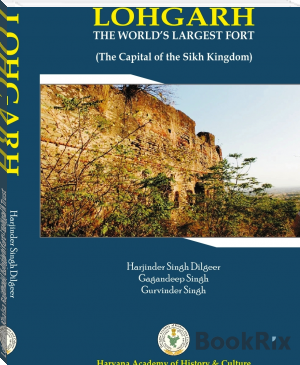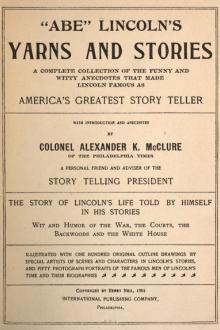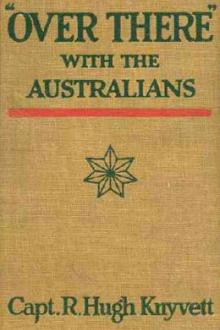Lohgarh - Khalsa Rajdhani, Lohgarh fort - Lohgarh Trust, S. Daljeet Singh Bajwa [early reader books .txt] 📗

- Author: S. Daljeet Singh Bajwa
Book online «Lohgarh - Khalsa Rajdhani, Lohgarh fort - Lohgarh Trust, S. Daljeet Singh Bajwa [early reader books .txt] 📗». Author S. Daljeet Singh Bajwa
Zamindar Literally: landholder. This was a term used for an
independent or semi-independent ruler of a large estate, one level below a ruling price. The zamindar usually held his rights to his lands directly from the paramount power, on a permanent basis and with a fixed assessment of the value of its revenue. He enjoyed the right to collect taxes, dispense justice at magisterial level, raise troops, police, etc. Most of the more important zamindars also held princely rank.
Bibliography
The present work is about the life and contribution of Banda Singh Bahadur. Banda Singh Bahadur became the greatest hero of the history of the Sikhs, the Punjab and South Asia through his unparalleled deeds and sacrifices for eight years (1708 to 1716). Luckily, several Persian sources have preserved valuable materials about this period. The Gurmukhi and Punjabi sources too have useful information.
Among the Gurmukhi and Punjabi sources, the best ones are the Bhatt Vahis (literally: registers of the Bhatts; the Bhatts used to record the births, marriages, battles, deaths of their ‘clients’; hence, these are a genealogical account of prominent Sikh clans, mostly Rajput and Khatri, written by their family priests commonly called prophets; however, it is not proper to call them priests; they were a sort of record-keepers). As the Bhatt Vahis had been written by the priestly class, hence they had presented the materials with exaggeration and might have concocted some stories also. But, their preservation of the record of dates, names of people and places is the most precious treasure of history of their times. The next work is Gur Sobha. It was written by Sainapati in 1711. This work covers the period between 1701 and 1709 only, hence no reference to Banda Singh.
The second stage of sources is the Gurbilas literature (biographies of the Gurus) which was composed in the second half of the eighteenth century or in the first half of the nineteenth century. They are replete with fiction and hagiographies materials besides several concocted stories, thus distorting the history. Three such works are often quoted: Gurbilas Patsahi 10 (1751) by Koer Singh, Gurbilas Patsahi Dasvin (1797)
by Sukha Singh and Gurbilas Patsahi Chhevin (1835-40) by some unknown author (by Gurmukh Singh and Darbara Singh as per Kahan Singh Nabha). All these three works present distorted history of the Gurus period. These too do not have much materials about the Banda Singh’s role.
Kesar Singh Chhiber (great-grandson of the Diwan Dargah Mall, minister of Gurus from 1644 to 1696) wrote the Bansawlinama Dasan Patsahian DA in 1769. The second part of this book is based on the author’s memoirs, but still it gives some useful materials about Banda Singh’s role.
In 1790, Sawrup Singh Kaushish wrote Guru Kian Sakhian, which was solely based on Bhatt Vahis. This book has very precious data of the Gurus - period and some information about Banda Singh too.
The next in this series are the works by Santokh Singh (Gur Partap Suraj Granth, 1839), Ratan Singh Bhangu (Prachin Panth Parkash, 1814/ 1840) and Giani Gian Singh (Panth Patkash 1890). Though, these books are a chronological account of the Sikh history, but all the three are replete with seriously distorted information. However, another work Shashi Bans Binod (1879) by Ganesha Singh Bedi has preserved some precious data of relations between the Gurus and the Bilaspur (Kehlur) state. Ram Sukh Rao’s Fateh Singh Parbhakar and Jasa Singh Binod (written in the second half of the nineteenth century) to have some good information.
The Persian sources are most valuable source of information about the Banda Singh’s period. Though a reference to the Gurus too can be found in Akbar Nama (Abu Fazal, 1601), and Tuzk-i-Jahangiri (1620s) but Dabistan-i-Mazahib (1645-46) by Zulfikar Ardastani (earlier mistaken as Muhsan Fani) has much detailed information about Sikhism (though it is an amalgam of right information and hearsay materials). Sujan Rai Bhandari’s Khulastut Twareekh (1696) also has some references to Gurus-period, but it covers the period up to 1695-96 only.
Most precious Persian sources narrating the Sikh situation are Akhbarat-i-Darbar-i-Mu’alla (literally: the news of the court of the Emperor); this is in the form of the reports sent by the agents of Jaipur
state (who used to be in the Delhi Darbar, as well as in the company of the troops of the Mughal Emperors). From this source, one can read daily diary of the events of the period 1707 onwards (till 1750s). We have used this record extensively, particularly the orders/activities of the Mughal Emperors and other officials as source of materials.
Among some other treasures of information written mostly during this period or about this period, are as follows:
Tazkiratu Salatin-i-Chagatta (written by Mohammed Hadi Kamvar, in 1724) is an account of the period from 1707 to 1724. He was an official of Rafi-Ul-Shan, the son of Bahadur Shah, and always accompanied him. His duties included sending day-to-day information to the Emperors. This book is in two volumes, the first volume covers the period up to 1707 and the second volume narrates the events up to 1724. Though Kamvar did not conceal his hatred for Banda Singh and the Sikhs, yet he has given a lot of useful information about Banda Singh Bahadur’s activities. He has given a detailed account of the Mughal attack on Lohgarh and escape of Banda Singh, battle of Sadhaura, arrest of Raja of Nahan, killing of the chiefs of Jammu and Sultanpur by the Sikhs, siege of Gurdas Nangal, arrest and martyrdom of Banda Singh etc. No other account equals his detailed description of attack on Lohgarh in November 1710, in which he himself was an eyewitness cum participant. Tareekh-i-Iradatkhani (by Iradat Khan, written between 1710s or 1720s) is an account of the first quarter of the eighteenth century. Iradat Khan, a former employee of Prince Mohammed Aazam, had joined the service with Khan Khana but after his death he retired from service and wrote this book. He too has given useful information about Banda Singh. Ibratnama (written by Mohammed Qasimi, in 1723) is an eyewitness account of the first two decades of the eighteenth century. He has given a precious account of the battle of Chappar Chiri, killing of the chiefs of Jammu and Sultanpur, siege of Gurdas Nangal and the arrest of Banda Singh. It was he who gave a true picture of the state of the mind of the Mughal soldiers mentioning how they dreaded even the simple mention
of Banda Singh.
Dastur-Ul-Nisha (written by Yaar Mohammed, in 1720s) is the only Persian source which mentions that some Muslims embraced Sikh faith after the Sikhs’ victory of Sarhind.
Ibratnama (written by Mirza Mohammed Harsi, in the 1720s) gives a detailed account of the battles of Chappar Chiri, Rahon and Gurdas Nangal as well as the martyrdom of Banda Singh and other Sikhs in Delhi in 1716. He has also given fine details of the procession of the Sikh prisoners in Delhi, taken out on the 29th of February 1716. His book has also recorded the statement of some of the Sikh prisoners. Mohammed Harsi was an employee under prince Rafi-Ul-Shan (son of Bahadur Shah) and had a mansab of fifty horsemen. He was a favorite of Bahadur Shah’s family; and he was chosen as escort to carry the dead body of the Emperor Bahadur Shah from Lahore to Delhi.
Shahnama (written by Mir Mohammed Ahsan Sajad, in 1718) is an account of the reign of Farukhsiyar. The author was the first to mention the name of Chappar Chiri village where the battle for occupation of Sarhind was fought on the 12th of May 1710. He has given a picturesque account of the killing of Wazir Khan in this battle. He is the first to give details of the first Sikh coin; hence this book is a valuable source of Sikh history.
Munavar-Ul-Kalam (written by Shiv Das, in 1722) mentions that Banda Singh had got initiation (Khanday Di Pahul) from Guru Gobind Singh Sahib.
Fathatnama Sammadi (written by Ghulam Muhai-Ud-Din, in 1723) is another precious work about this period of Sikh history. The author has given an eyewitness account of the battle of Gurdas Nangal and the arrest of Banda Singh and other Sikhs in December 1715.
Muntakhab-Ul-Lubal (written by Khafi Khan, in 1731) has recorded the history up to 1730. Though this work lacks accuracy about the dates and even the chronology of events too is faulty, but it has given the story of newly wedded young Sikh boy who refuses to be released on the plea that he is not a Sikh. When his mother presents Kotwal’s letter to release him, he yells: ‘she is not my mother; I am a Sikh; let me join my martyr brethren.’ Khafi Khan has also presented details of the
procession on 29th February 1716 when Banda Singh and other Sikh prisoners were paraded in the streets of Delhi. It is he who had recorded the statement of Banda Singh about his reasons for the declaration of war against the Mughal regime. He is the first to refer to the Sikhs’ coining of the slogan of fateh darshan.
Mirat-i-Wardat (written by Mohammed Sufi Warid, in 1734) has also given some detail of Banda Singh’s march from Nanded to Kharkhauda, battle of Chappar Chiri, killing of Wazir Khan and some later events. This work is important because it gives details of the implementation of an egalitarian system by Banda Singh after victory of Sarhind.
Tarikh-i-Mohamamedshahi (written by Khushal Chand) has referred to Banda Singh’s initiation into Sikh faith as well as the description of the execution of the newly wedded Sikh boy who refuses to save his life by declaring himself a Hindu and not a Sikh as his mother tries to present. His account almost resembles the account given by Khafi Khan.
Muasar-Ul-Umraa (written by Shah Nawaz Khan Shamas-Ud-Daula, completed in 1757-58) gives information about the officers of the Mughal Darbar, from the time of Akbar (1556) up to 1757 (i.e. A period of about two hundred years). Shah Niwaz had access to the record of the Mughal Darbar; hence he has given precious details of the role of these officials. These officers include Governors, Faujdars, Diwans and other officers of Lahore and Sarhind too. From these details one gets a lot of information about their dealings with the Sikhs. This book was translated into English by Asiatic Society of Bengal, in 1888.
Three latest books about Banda Singh Bahadur have rich information about the period between 1710 and 1716. These are: 1. Banda Singh Bahadur: Farsi Sarot (in Punjabi), compiled by Balwant Singh Dhillon (published in 2011 by Singh Brothers Amritsar) 2. Muhammed Qasim Aurangabadi’s Ahwaal-Ul-Khawakeen, edited by Dr Balwant Singh Dhillon (published in 2012, by Singh Brothers Amritsar) 3. Rajasthani Documents on Banda Singh Bahadur, compiled by Balwant Singh Dhillon (published in 2016 by Singh Brothers Amritsar).
The English Sources:
The early English sources do not mention much about Banda Singh; the only information available from the English sources is a letter written by John Sermon and Edwards Stephen, on the 10th of March 1716, to the then British Governor at Fort William (Calcutta), which mentions the execution of seven hundred Sikhs at Delhi. This has been published by Dr Ganda Singh in the book Early European Account of the Sikhs. The English have referred to Banda Singh in other works too, but all these books/reports were published either in the second half of the nineteenth century or in the first half of the twentieth century. Slight reference to this incident has also been given by C.R. Wilson in Early Annals of English in Bengal. However, Irvine, in his work Later Mughals, has





Comments (0)